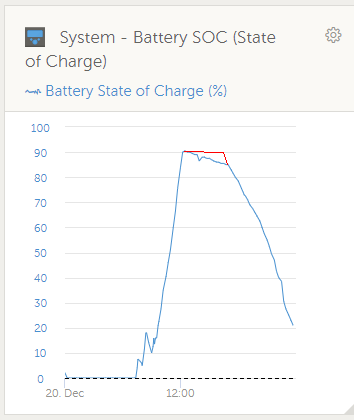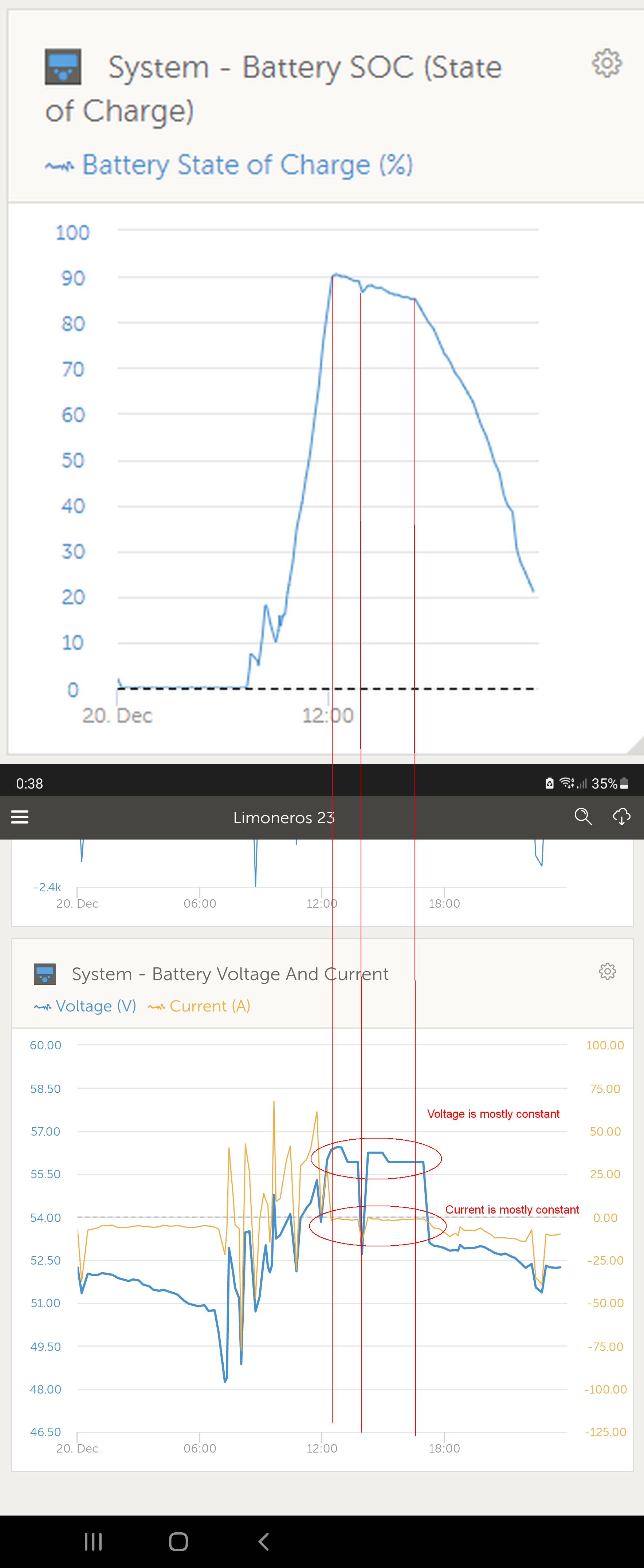
- Home
- Anonymous
- Sign in
- Create
- Spaces
- Grafana
- Node-Red
- Unsupported topics
- Questions & Answers
- Modifications
- Communauté francophone
- Deutschsprachiger Bereich
- Preguntas en Español
- Explore
- Topics
- Questions
- Ideas
- Articles
- Badges
question
Multiplus II does not refill?

Many battery manufacturers indicate that LFP does not need to be floated. That is true if you're just placing them in storage. However, when using them in cyclic power system, a float voltage is needed so the MPPTs provide solar for loads trying to pull the battery voltage down.
Set float voltage to 3.4V/cell, 54.4V.
SoC curve will look like this:

Given that you are only achieving 90% SoC, you may wish to review how you're charging the battery.
thank you so much for your answers. Yes I think ESS is what I use. I was told that as batteries were lithium, discharging them to 0% was not an issue.
Any idea why batteries don't reach 100%?
Discharging to 0% isn't an "issue", but it's not best practice. For maximum cycle life, you don't want to discharge below 20% regularly. Discharging to only 20% may double the life of the battery.
Your MPPT and BMV settings likely are not set appropriately, and your battery is getting to near 100%, but it's just not accurately reported.
It's uncertain why your SoC drops when you still clearly have solar available in excess of your loads. We will dig into this after sorting out the MPPT & BMV.
EDIT: Based on your device list, you don't have a BMV. If your system is using the battery monitor in the Multiplus, that would explain why it's not getting to 100%. Please post a capture of your battery voltage and current for the same period you posted for the SoC.
This is what you asked for? 
Please post the settings of the MPPTs and multiplus.
While lithium batteries can be discharged to zero, doing so often will reduce their lifespan. If you are using ESS, in your ColorControl GX you have a setting named "Minimum SOC (unless grid fails)", which apparently is set to 0%. Increase that to at least 10% (or, even better, to 20%). But you should also check the battery voltage and cell voltages, especially when the battery is (close to) empty and when it is full.
I would love to, but I'm the final user, I have no idea how to reach that, it has been set by the dealer.
Either ask these questions to your dealer or start by reading the manuals of all your components (and after that you should be able to post the settings).
If those VCSF files contain the actual config of your MPPT, your installer did NOT set your MPPT appropriately at all, especially for Lithium.
You need to IMMEDIATLY DISABLE temperature compensation.
Revise BOTH as follows:

If you have a BMV-712, please upload it's configuration.
The ESS settings may have triggered charging due to the settings. I'm guessing at that.
I entered in panic and set it back to where it was, then sent your instructions to the dealer to see what they have to say. Can they reach MPPTs configuration remotely?

I've drawn vertical lines to find the same time on each chart. Your voltage is mostly constant (blue line), and the current is mostly constant (orange line), though it does appear the current is slightly negative. This doesn't make a lot of sense.
You do indeed appear to be losing that ~5% SoC even with available solar.
This is likely a calibration or configuration issue, and it shouldn't be like this. You should contact your installer to have them resolve it. It's not working as it should, and they should fix it.
If you are using ESS, then the MPPTs are controlled by the Multiplus.
It's still good to have the MPPTs configured properly for your battery, but as long as ESS works as it should, these settings will be ignored (except the charge current).
As I said, if you have to change the settings, first read the manuals.
Thank you very much for your answer. You are quite right that reading the manual is key, but to understand what it says you must first have basic electricity knowledge, wich I lack absolutely. I'm not sure about the difference between a volt and a watt.
Related Resources
Additional resources still need to be added for this topic
question details
42 People are following this question.
